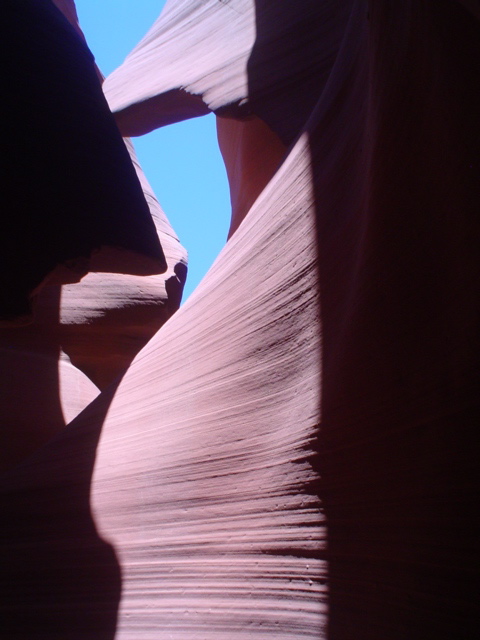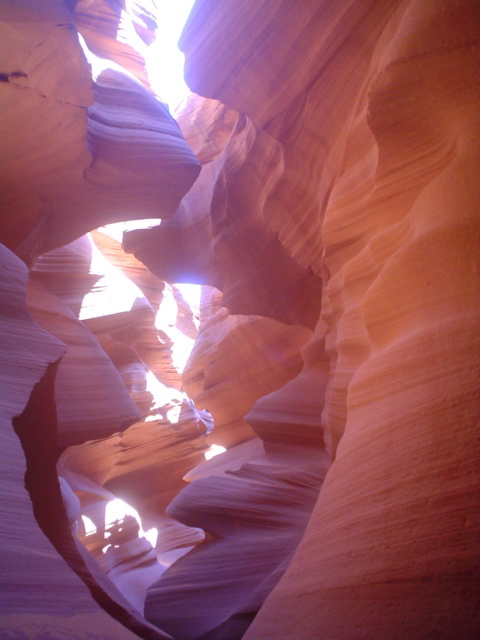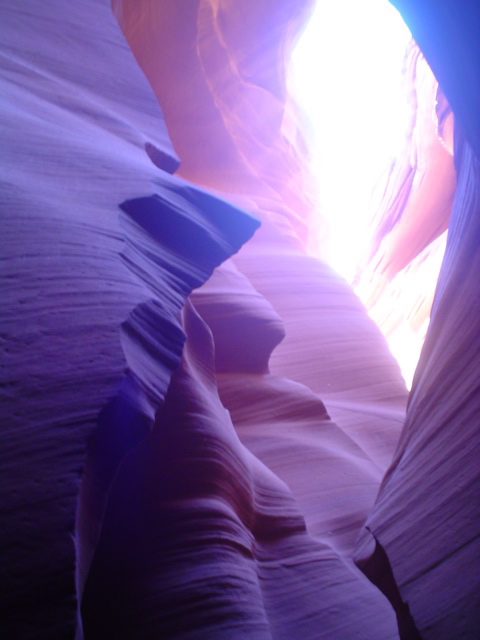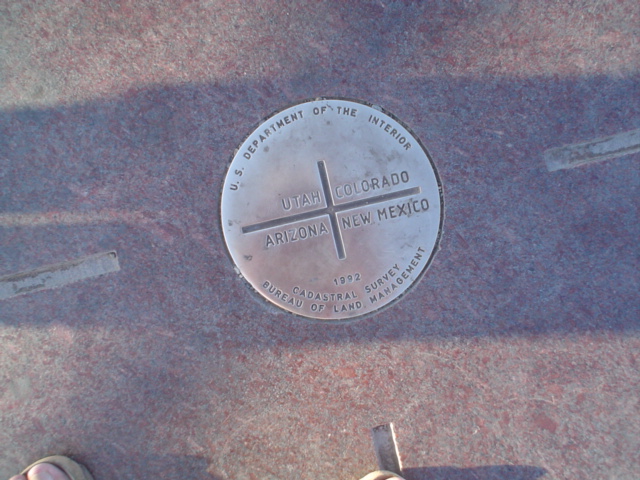Le Sud-Ouest, Der Südwesten, Or Il Sud-Ovest
One of the most striking features of the desert is its silence.
Take a walk in the desert, and you won't hear much unless the wind is blowing strong enough to whisper faintly. People are few and far between, so even human speech doesn't intrude much at all. When I planned a vacation out to some desert sights, I had no idea that the silence would be the most welcome thing about the trip. While traveling, I was not listening to any news, and therefore missed most of the town hall frenzy which took place (although I did manage to catch most of Obama's town hall in New Hampshire on television, right before checking out of a motel).
But, while the silence was indeed relaxing (in comparison to following the news as closely as I normally do), one of the most striking things to me from the trip came when the silence was broken by people talking. Because in roughly about 80-90 percent of the cases, the language spoken wasn't English.
But before I get into that, let's start with some vacation photos. These first three are from one of the most awesome natural formations anywhere on Earth -- Antelope Canyon. This is one of the few places on this planet you can go where it is almost impossible to take a bad picture. Don't believe me? Take a look:

This canyon is located a few miles east of Page, Arizona, and I've been looking for it for a long time -- around 20-25 years. You might recognize the photos, as pretty much any calendar or photo book of the American Southwest will have a few shots of it. As I said, the place is a photographer's dream. The canyon is what is called a "slot canyon" made of red sandstone and, in places, is barely wide enough to squeeze through. Here's another shot, showing the sandy floor:

But what is truly spectacular about the place is that when strong light is applied to a reddish atmosphere, the shadows turn deep purple and blue. This, even though your naked eye doesn't pick it up, makes for spectacular photography. This photo has not been altered at all:

As you can see, walking through one of these slot canyons is an unforgettable experience for a photographer. Or even without a camera, for that matter.
You might wonder why it took me so long to find the place. I was raised on Rand McNally road atlases, and have always used them for my road trips. One of the reasons I like these maps is that they mark "points of interest" along the way. Now, they do have standards for what constitutes a valid point of interest, to weed out the tourist traps (the "world's biggest ball of twine" doesn't make the cut, in other words). But this canyon is not marked. And I have no idea why.
It's run by Navajos, since it is on Navajo Nation land. You can't miss the place, since there is only one road out of Page to the east and the parking lots are right next to this road. You can choose either the Upper or Lower canyons (these photos are from Lower Antelope Canyon), and you pay a Navajo guide who takes you through the place. Ours brought a guitar, which echoed wonderfully off the walls as we strolled through the canyon.
So why isn't it on my Rand McNally map? It's not a tourist trap, it's a miracle of nature. Another miracle of nature, one that is far better known, is also not marked as a point of interest on Rand McNally, either -- Monument Valley. If you've ever seen an old John Ford western, you will recognize the place immediately, as it has the most scenic desert rock formations ever filmed (even it the movies were a bit cheesy). There's a "Navajo Nation Park" with a loop drive through the valley floor. If this land didn't belong to the Navajos, this would be a National Park (or, at the very least, a National Monument). But it does belong to the Navajos, and neither place is marked on Rand McNally. Perhaps there's an ongoing feud between the mapmaker and the Navajos, that's the only thing I can think of. Maybe I should write Rand McNally a letter or something....
One little park inside Navajo lands is marked on the map, perhaps because so many people know about it. This is "Four Corners," where the states of Utah, Arizona, New Mexico, and Colorado meet at the same point -- the only such point in the United States. We went to that, too:

But this wasn't supposed to be a screed against Rand McNally, nor just a chance for me to show some vacation photos. We're supposed to be talking about languages here. Sorry, it's always a little hard to focus after a vacation (which is why I'm not digging in to politics until tomorrow).
The first foreign language we heard spoken was either Navajo or Hopi -- on our radio. I was flipping around the stations to see what the locals listened to, and came upon a woman reading in some Native American language (having no knowledge of them, it was impossible for me to identify). Which, I have to admit, was pretty cool to hear. More power to the tribe, for keeping their ethnic heritage alive in such a fashion. The Navajos famously helped out the American war effort in World War II as "code-talkers," using their native language over the airwaves in a "code" the Japanese never broke. So it was appropriate to hear over the radio today, in a way.
But the tourists were what really began to interest me. I heard people speaking Italian, German, French, Dutch, Japanese, and a few other languages I couldn't identify. I spoke some (very bad) French with some French Canadians, who were astonished at an American even attempting to speak French, and were very polite as I mangled the language (but managed to make myself understood on a basic level).
Now, don't get me wrong. I am in no way anti-foreigner. If I was, I wouldn't have married one. So please don't interpret my comments here as "them dang furriners" in any way -- these are just casual social observations.
But what was mind-blowing was the proportion. I flipped through the sign-in sheets at Antelope Canyon, and nine out of ten names listed other countries than the U.S.A. This proved to be the case throughout our travels in the Utah and Arizona desert. There were signs at cash registers showing which coins were which denominations, to help those unfamiliar with American money. There were "free breakfast" signs in German at hotels in dinky little remote towns. And there were foreign tourists everywhere you looked, and very few American tourists in sight.
Now, I've lived in France, and I have to say the French have a deep fascination for the American Southwest. Ask any French kid over the age of about six, and he'll tell you who Tex Avery was. Ask any French homme-on-the-street, and they'll tell you all about Route 66. I don't fully understand this fascination, but it is widespread in France, I know this from personal experience. I have to now conclude that this interest goes beyond France to encompass much of Europe as well.
I did ask a few locals about the phenomenon, and they told me there have always been European tourists, but about three years ago it became an absolute flood. Meaning that part of the reason may be the state of the dollar. Only about a decade ago, the dollar traded even with the Euro (the Euro was pegged one-for-one with the dollar when it was first introduced). Now, it costs a dollar and a half to buy a Euro. Meaning that Europeans' money goes about 50 percent further in America as it used to. Making American vacations relatively cheap for them. Which is great for the American economy -- in particular, these small desert towns who are cashing in on the influx. So it's not like it's a bad thing in any way.
But I do wonder about the flip side of the coin: where are the American tourists?
Now, this area is pretty remote, I have to admit. Also, it's hot, especially in August. And in France (for instance), virtually everyone gets the entire month off on vacation (most of the rest of the industrialized world gives their workers two or three times as much vacation as American companies). But still, even allowing for all that, only finding ten or twenty percent of our fellow vacationers Americans was interesting.
Maybe it's the poor state of our economy. Perhaps people are putting off long vacations and road trips due to the state of family budgets and the price of gas. All of the places we visited are pretty far from any city -- meaning flying in to see them is simply not an option. And, because we had already seen some of the more well-known sights in the area, we avoided places like the Grand Canyon -- which may also be part of the explanation.
I have no overarching conclusion here. As I said, it's always a little hard to focus after a 2,500 mile car trip. I guess my only point would be to encourage Americans to visit the "four corners area," the Navajo Nation, and the spectacular desert sights in southern Utah and northern Arizona. The rocks out there have been around for a few million years, and they'll be around a few million years after we're all gone. This might lead folks to put off visiting them. But, when you get away from people talking (in any language) and realize how small humanity is in the grand scheme of things, it gives you a new perspective.
In the desert, no one can hear you scream (at a town hall meeting). I guess that's all I'm really trying to say.
-- Chris Weigant






Back up and running again. To all, I will read through the comments you posted in my absence tonight, and attempt to answer some of them. Thanks to everyone for (mostly) behaving yourselves while I was gone!
:-)
-CW
Welcome back, Chris, we've missed you. Great article and pics, I'm going to send this to a few of my friends just for the pictures alone. Hope you and the Mrs. are burn-free; up here in B.C. we've just endured a brutal (for us) heat wave. Yech.
Kevin
I know exactly what you mean by the ‘silence’. It reminded me of the Big island of Hawai’i and the enormous Parker ranch - it was there that I learned how deafening the silence can be!
As for all of the European tourists...it has been my experience when I was working with an Aboriginal rights group that many Europeans are fascinated with all things ‘native’...as in North American Indians and their cultures. I’m not sure where it comes from - could it be based in some sort of 'old world' guilt!? Probably not, but this interest in native culture may begin to explain why you saw so many Europeans exploring Navajo nation territory.
You have some breath-taking pictures of the Lower Antelope Canyon - it sounds like a memorable trip.
Welcome back, Chris!
Elizabeth -
Been up Mauna Kea? Wind blows so hard up there, you don't just hear it, you have to lean into it to stay upright!
Tallest mountain in the world! Not highest, but (measured from base to peak) without question the tallest.
:-)
-CW
kevinem2 -
Now that you mention it, the day after we got back, the hills caught on fire here....
The hottest temperatures weren't in the desert, believe it or not, but in the San Joaquin Valley (the "Central Valley") in California, coming home (106 deg. F). Whew!
-CW
Thanks to everyone for (mostly) behaving yourselves while I was gone!
I resent the implication that I actually (mostly) behaved myself! :D
Glad yer back. I got so bored I actually got into a furball over at HuffPo.. :D
Michale
I have motorcycled 46 states and I am always drawn back to this beautiful area. It may be America's most peaceful and beautiful. Great pics, Welcome back.
Chris,
I was actually hoping you and Mrs. W. avoided sunburns on your trip. Myself, to paraphrase Woody Allen, don't burn, I stroke :-)
Kevin
First, a political comment ... wow. look at those pictures!
David
Chris,
Mauna Kea is a beautiful place, though I have not been up it...yet!
I have been down into Haleakala crater, though, on horseback and the ambient sounds there are quite fascinating, too.
Thanks for the link. How did you end up there - helicopter/ski tour or star-gazing?
I’m seriously thinking it’s time to go back, especially considering that, in my neck of the woods, this summer (if you can even call it that) has been the wettest, coldest, and cloudiest on record. Well, that and the fact that my mouth is watering for some kalua pua’a.
Beautiful pix, thanks for sharing. I haven't explored the area in depth, but did stop in Utah during a cross-country trip once to check out a canyon. The silence was incredible, like a physical sensation on the eardrums, almost like a living presence, it felt like something waiting, hard to describe and I don't mean that to sound paranoid , it was really beautiful and especially when traveling with 2 kids :) It made me think it might be the source of the religious beliefs of the native peoples in that area.
Elizabeth -
I went up Mauna Kea because I am drawn to geographical oddities, such as South Beach (southernmost point in the entire USA). Mauna Kea is the highest point in Hawai'i. I've been to 34 of these, personally, but Mauna Kea was certainly the most fun trip to get there!
I invite everyone to join me in wishing Hawai'i a happy 50th (statehood) birthday!!
:-)
propitiousmoment -
Where did you stop? I've been to the region three or four times, but haven't seen more than about HALF of the interesting stuff out there.... First time I checked it out was when I detoured off the Interstate to see Arches.
-CW
Elizabeth -
Oh, forgot to mention, "we drove up, in our rental Jeep."
When we rented the Jeep, we were told not to go to three places on the island. We managed to get to two of them (Green Sand Beach, and the summit of Mauna Kea). The third one was a road through a valley, it'll have to wait until next trip...
:-)
-CW
Ha!
I'm guessing you mean the Waipio Valley...
It's always a running joke about which roads you can't travel on! Try and stop us - although, I have to admit, it was by guided tour that I travelled the road through the Waipio Valley...very nice, just the same, though...
Did you hike the Na Pali trail from Ke'e Beach...in the mud!?